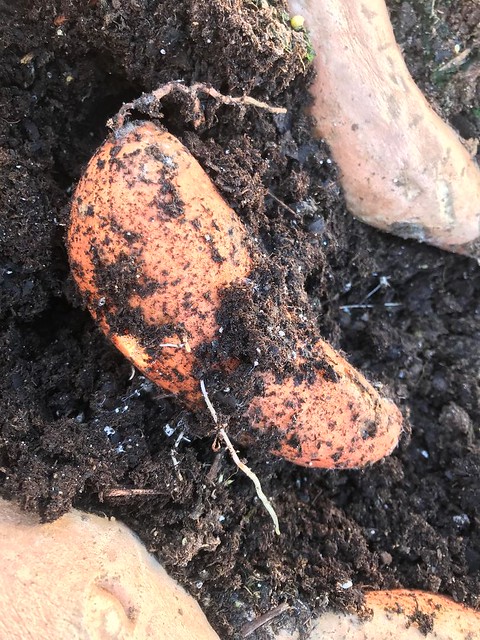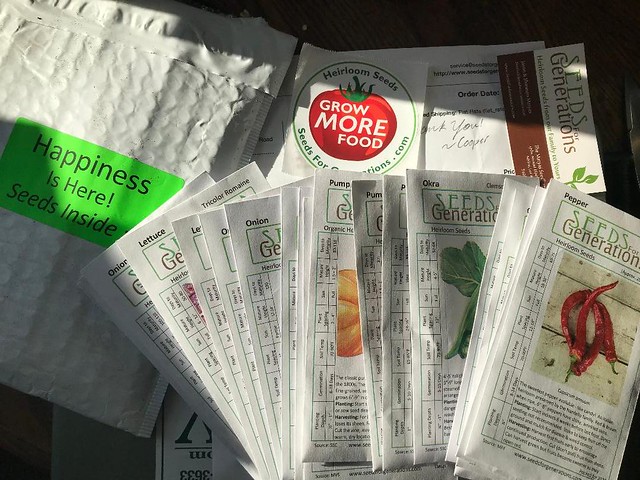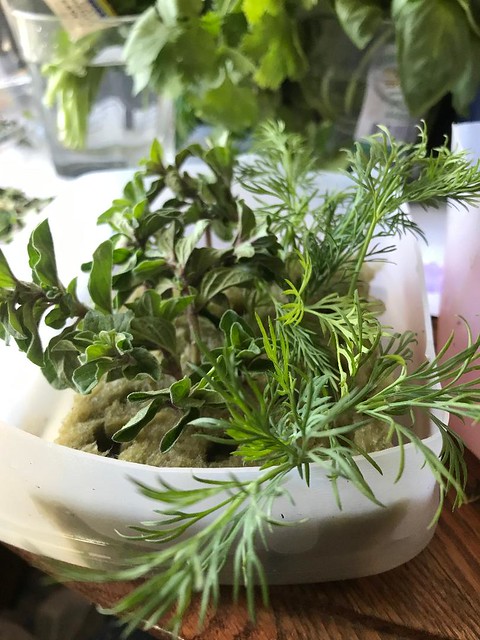I wrote this to help a group of young women. I am sharing this here for anyone else who can use it. I believe we should help each other along as much as possible right now.
Anything new can be overwhelming at first, but as soon as you get some knowledge and experience under your belt, it will become easier and you will gain confidence. Here are some steps you can work through one thing at a time. It's a lot of information, but some of it will help you avoid things that can determine your sucess or failure. You can use these short notes of mine as jumping points to start your own research and expand your knowledge base so your skill level will go up quickly.
Figure out your growing zone. You can learn that info by your address through an online search.
The very next thing I would do is join gardening groups or forums specific to your area. They may be based on the growing zone, zip code, or the name of your location. Find local agencies that help people learn to grow their own food. For me, we have a Master Gardener's association and Virginia Cooperative Extension.
Seek out the gardeners in your area who have experience growing edible gardens. They can save you some disappointment. I've learned tomatoes do not do well for me in 5-gallon buckets because of the heat we get as early as late May. They stop producing in May if I do put them in buckets. If I keep them in the ground, they keep right on putting out the fruit because the ground keeps their roots cooler.
Seed to Spoon is an app that will tell you what you can start inside or sow outside right now by your growing location. I do not know if it works for Canada. I am in the US. I have lists of when I can start things printed out. I am using this tool to add to my lists.
Figure out how much space you have and what the conditions are in those different areas are. That will dictate what and how much you can grow. I have very shady to very sunny spots with some spots always underwater and other areas that get very dry in the summer.
Will you garden on window sills, containers, in the ground in grows, in a raised bed, or do like me and use a combination? You need to know what and how much you can grow in each.
Figure out the main crops you want to grow. I have a large family and look out for a few others, so I need a lot of food. With that in mind, I researched the heaviest yielding crops that do well where I live when I started gardening a long time ago.
Soil temperature is a more reliable way to plant than by the calendar. The calendar is useful as a general rule of thumb. If the temp is too cold or too warm to germinate, the seed will sit there and rot. Just because it is a certain date does not mean the ground is ready. There are online sites you can check to get the soil temperature in your area.
Research heirloom and hybrid seeds. Learn the pros and cons.
Research the growing issues in your area (online forums, groups, neighbors who garden), and buy varieties that are more resistant to those issues. For example, I tried growing old heirloom varieties of squash that are more resistant to vine borers.
Buy good quality seeds. Some people are repackaging old seeds and selling them online. Seeds for Generations (family-owned and run) has been very good about filling my orders. Their seeds have had excellent germination rates. And, I have bought a pile of seeds from them...at least $150 worth.
For those in the states, I have not had good success from DollarGen store seeds. They also have fewer seeds per package and cost more. Dollar Tree has had seeds that germinated well and they are a quarter a package in my Hampton Roads. They also have more seeds per package than DollarGen.
Look up your local feed and seed store. I have never purchased bad seeds from the two I use in my area. Some seeds can be purchased by the pound for less money and will give you a few years' worth of seeds for less money. I buy seeds I know will last 5-6 years this way.
Save the seeds you get from produce in the grocery store. All of the squashes, pumpkins, watermelons (seeded) have germinated well for me. The hybrid tomatoes and green peppers have not done well for me.
Consider the grocery store a source of seeds. Dried beans will sprout. .7 grams of black-eyed peas from a seed company costs 1.99. I can buy the same seeds from the grocery store for 1.48 a pound and come out way ahead. Lentils, brown rice, fennel and celery seeds, millet (not just for birds), and many other things will sprout and grow. Roots and rhizomes will grow. You may need to be patient while you wait for any root inhibitors to wear off.
Buy sprouting seeds. I have found bulk seeds cheaper per ounce sold as sprouting seeds.
Learn how to store seeds properly so they will be viable longer.
I keep the bulk of my seeds in folders in two plastic file boxes. I write their growing needs including soil temperatures to germinate on the outside of the folders so I always have it accessible.
To start my plants indoors (cause this girl is not paying $5 per tomato plant), I useBarrina LED T5 Integrated Single Fixture, 4FT, 2200lm, 6500K (Super Bright White), 20W. You get six for $45 on Amz. I cut the plastic covers off to increase the light. These lights are sufficient to start plants for planting outside. It can also grow leafy greens to harvest. I have also grown microgreen successfully under these lights. For something that needs to flower (squash, beans, etc) that you want to grow completely inside, you will need full-spectrum growing lights. However, these are a cheap way to get your own plants going. I use three of these lights per shelf.
For most setups, keep the started plants very close to the lights (about an inch under), I get them close by putting shipping boxes I cut underneath the plant trays. I cut the box down to size and turn it upside down to support the plant tray. I cut the platform down a bit as they grow and eventually send it to the compost pile. Keeping the plants close to the lights keeps them from being leggy and weak from light deprivation. If you have a fan circulating air around your seedlings, they will be stronger and will do better when hardening them off.
Hardening them off is basically introducing them very slowly and very carefully to the outdoor growing environment. Watch your plants carefully when you are hardening them off. In the mornings, I put mine on the shady side of the house with some protection from the wind. I check them every 15 minutes on the first day. I leave them out until I notice they are just starting to droop a tiny bit. Then I bring them back indoors. The next day, I try to go a bit longer and so on until they can stay out overnight. I use an alarm on my phone so I do not forget to check on them. Think of them as nervous and anxious little friends who need to go slowly with breaks.
Do the board method for planting carrots or other tiny seeds. This information is available on YouTube. I use that and also make my own carrot seed tape (also on YouTube) because I put carrots in small areas where I can't place a board.
For everything you do, there will be some who say you can't do it. Ignore the naysayers and don't be afraid to try. For example: I use grocery store potatoes for my garden. My family has done it successfully for generations.
I use intensive planting. Why give a weed room to grow when an edible can grow there just as easily. For many things that has worked well for me. However, sometimes it hasn't. I learn from it and keep moving forward.
If you cut the top 2" or more off of a carrot or parsnip and plant them, they should grow and you can get seeds from them this year. You will not get another big edible root though. I have parsnips growing on my windowsill right now in my home for this purpose. Celery and many other vegetables from the grocery store will regrow. This information is also freely available on the internet.
Do a soil test (kit here #amazonaffiliate "As an Amazon Associate I earn from qualifying purchases.”) to find the nutrient analysis of your garden soil so you will know what to put down to help your plants grow.
Research natural fertilizers and learn how to use them. For example: I grow comfrey for this and medicinal purposes.
Learn the common pests in your area and how to combat them. Everything living outdoors is trying to do what we are trying to do...survive. Don't make your garden an easy place to get an easy meal.
Sow your different varieties of the same crop (corn for example) far enough away from each other they won't cross pollinate so your saved seeds will be true to type.
Don't be easily discouraged. If at first you don't succeed, try, try, try again. Just keep experiementing. I plant seeds in different situations each year to learn what works the best for me.
Instead of watching frivolous things that do not add value to your life, choose to watch gardening shows and youtube videos. You can rest your body and learn at the same time.
When my family asks me what I want for a gift, I ask for fruit trees and berry bushes. I've done this for many years now. It really adds up over time. I don't buy cut flowers, but I will buy a potted herb that can be used for medicine, bug repellent, or as a seasoning.
Gardening is a worthwhile skill to develop. In my opinion, it should be taught in our schools since everyone needs to eat every day. I homeschooled my seven. They all know how to properly save and store seeds, propagate by air layering and other methods, grow their own food, harvest it, and perserve it. My oldest daughter has been growing tomato plants in her spare bathroom all winter. She's been cutting and rooting the suckers to make new plants. She already has more plants than she needs and is gifting my oldest son and I with several plants this year.
Happy Gardening! My love to all!























